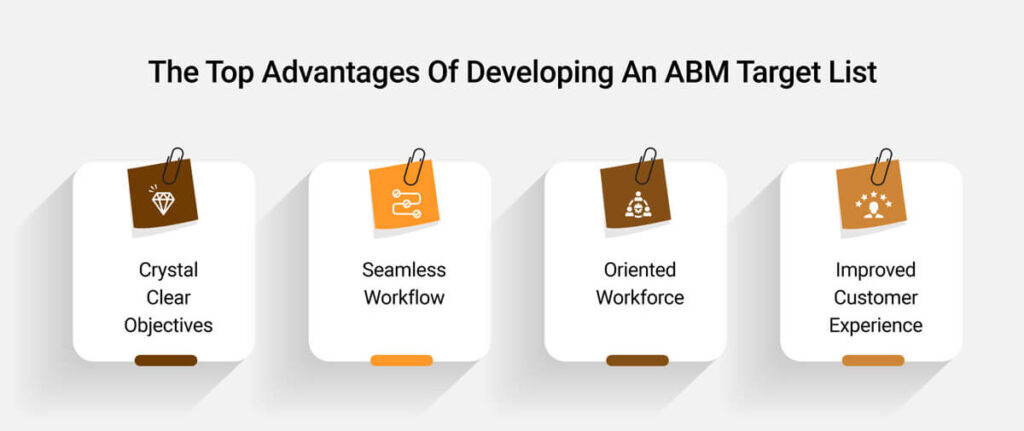
Building an ABM target account list (TAL) with all the data-qualified accounts that may become the ideal fit for your company in terms of company size, revenue, and technology usage, is a top-notch implementation of an ABM approach.
Prospecting is no easy task, as any professional B2B marketer would attest. Accessing the proper high-quality connections requires a lot of work and dedication from a firm, even with the help of tools like LinkedIn’s Decision Maker Insights Report, which examines roughly 1.7 million essential profiles of the most pertinent sectors.
Because of this, an increase in account-based marketing (ABM) strategies in daily workflow was noted by 70 %. This pattern demonstrates that tailored content (56%) and sophisticated data management (43%) are key elements in archiving for more lucrative conversions.
To understand more about how to make your very own account ABM list, keep reading.
Must Read: Account based marketing tactics in 2023
Account-Based Marketing (ABM): How To Use It For Your Business
Table of Contents

A group of marketing tactics known as “account-based marketing” are those that exclusively target a small number of exceptionally lucrative accounts. These contacts must go through several validation and categorization procedures to validate their worth before being targeted with tailored strategies to guarantee their conversion in order to enhance the target account selling response.
Lead-based marketing and account-based marketing differ significantly in key ways. The marketing team is in responsible of producing content, running advertisements, and enticing leads to their call-to-action (CTA) alternatives in the first scenario. After then, marketing shifts to a more supporting position as the sales team starts utilizing the leads that were generated.
Instead of merely providing a huge quantity of unqualified leads for the sales representatives to qualify (Marketing Qualified or Sales Qualified), target account selling tactics require marketing to verify that certain conditions are applied to the lead before forwarding it to sales.
Sales and marketing must collaborate from the start in order for this to be possible. If these two forces of nature can learn to communicate and work together, they should be able to create an ideal customer profile (ICP) that is useful, accurate, and reliable for every desired account. This ICP serves as the basis for the success of account-based marketing (ABM).
How To Build The Perfect ABM Ideal Customer Profile
A detailed dossier called a “ideal customer profile” (ICP) contains information on a business that is both a good fit for your product and has a good possibility of becoming a client.
Similar to a buyer persona, this straightforward but effective tool aids businesses in highlighting pertinent details about their contacts, including titles of decision-makers who need to be targeted, location, the number of clients they currently have, industry, technologies employed, revenue, and more.
The more information an ICP has, the more it will aid a company in properly comprehending how, when, and where to implement its marketing and sales initiatives. The steps required to finish this information-rich profile might be time- and resource-intensive, but the following internal practices can help you build a strong ICP.
ABM – Target Account List: What Is It?
A target account list is a compilation of all the qualifying ICPs that your marketing and sales teams were able to identify with the aid of all other relevant departments.
Every detail you know about your ideal client should be included in this document, as it will serve as a step-by-step guide for your team on which firm to contact first, when to contact them, and how to contact them.
Your TAL helps you understand which type of content, advertisement, or call-to-action (CTA) would perform better in each case, making your follow-up process a custom experience for each targeted decision-maker. This TAL not only enhances your account-based marketing actions, but it can also become an astounding source of data-driven decisions.
It goes without saying that with elite ABM connections, this is the best course of action.
While some businesses choose to purchase target accounts from arbitrary data suppliers, working with internal target account marketing strategies has several advantages. Here are a few illustrations.
Must Read: Implement Automation Tools To Soar Your ABM Efforts
The Top Advantages Of Developing An ABM Target List

Every B2B lead generation strategy is immediately impacted by engagement-driven ABM lists. One of the most well-known outcomes of a well-structured ABM strategy is the creation of new meetings, the expansion of account leads, and the retention of account leads.
Even if it’s challenging to establish a strong network among all internal data owners, the benefits listed below could persuade them to lay down their spears and partake in the account-based marketing feast:
Crystal Clear Objectives:
Teams will be able to use their budget, time, and resources more effectively with a better-defined focus, leading to a greater total return on investment.
Seamless Workflow:
Each team member will be given clear instructions on how, when, and where to take action. The boundaries of each action shall be accurately recorded to prevent any needless effort wastage.
Oriented Workforce:
After collaborating to develop the TAL, it is normal for sales and marketing communication to increase rapidly, leading to contact-immersive inbound and outbound actions.
Improved Customer Experience:
A better customer experience is something that every successful B2B lead generation firm strives to achieve throughout the buyer’s lifetime. Personalized follow-ups are only possible when all departments are dedicated to achieving the same goals.
Deliver Great Quality Leads Using ABM
Every B2B company’s primary objective must continue to be new business generation. It all comes down to deciding where your company wants to go next given the abundance of data management tools, tried-and-true strategies, and innovative marketing techniques available.
Even if having a targeted list of your most desired high-quality leads does not ensure that you will be able to contact them all at once, it is definitely a fantastic place to start.
No matter whether you decide to combine the insights from all of your client-acquisition departments or to hire a B2B data partner, keep in mind that the only reliable method to judge how wonderful your data is is to put it to use. Prepare your cold call script, write your email reply, and tell your staff to go through the contacts on the list. And if you are facing any challenges with it, feel free to get in touch and our team will be ready to resolve it for you.
Must Read: A Brief Guide to Generate Leads Using ABM Content Syndication

Vikas Bhatt is the Co-Founder of ONLY B2B, a premium B2B lead generation company that specializes in helping businesses achieve their growth objectives through targeted marketing & sales campaigns. With 10+ years of experience in the industry, Vikas has a deep understanding of the challenges faced by businesses today and has developed a unique approach to lead generation that has helped clients across a range of industries around the globe. As a thought leader in the B2B marketing community, ONLY B2B specializes in demand generation, content syndication, database services and more.


